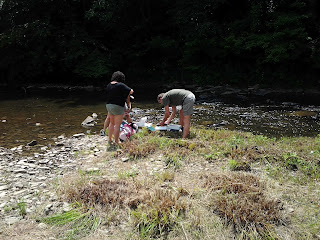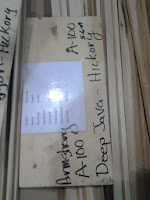Water quality was tested on the Greenbrier River three different times on our trip (results below). At the beginning of the river where the Kanawha's backwater enters the river, the overall water quality was 65.53. This would be a a medium or average reading on the water quality scale. Water
supplies achieving only an average rating generally have less diversity of aquatic organisms
and frequently have increased algae growth. It was raining the day we did this test. Do you believe this may have had an effect on our results?
 |
| Members of our group sampling at Durbin. |
The middle location we checked was at Durbin. We found the overall water quality to be 74.085. This falls into the good category on the scale. Water supplies with ratings falling in the good or excellent range would able to
support a high diversity of aquatic life. In addition, the water would also be suitable
for all forms of recreation, including those involving direct contact with the water.
The end location for our analysis on the river was at Cass. We found the water quality here to be 49.97. This is in the fair category of the scale. Water supplies that fall
into the poor category may only be able to support a limited number of aquatic life forms.
| Brian calibrating our instruments prior to performing water analysis. |
| The Greenbrier River at Cass. |
While I would expect and did see various forms of life ranging from fish, snakes and crayfish, there are sections that lead me to believe their are contaminants entering the water source. What types of contaminants do you think may be present?
| Water Quality | ||||||
| Test | Sample | Q-Value | Weight | Total Q-Value | ||
| DO (actual) | 5.37 | |||||
| Saturated DO reading from chart | 7.67 | |||||
| DO (% saturation) | 70.01 | 75 | 0.32 | 24 | ||
| Temperature Celsius) | 26.46 | 15 | 0.19 | 2.85 | ||
| TDS (actual) | 114.54 | 85 | 0.13 | 11.05 | ||
| Turbidity (actual) | 17.23 | 61 | 0.15 | 9.15 | ||
| pH(actual) | 7 | 88 | 0.21 | 18.48 | ||
| Date: | 7/21/2012 | |||||
| Overall Quality | 65.53 | Location: | Lewisburg | |||
| Water Quality | ||||||
| Test | Sample | Q-Value | Weight | Total Q-Value | ||
| DO (actual) | 6.7 | |||||
| Saturated DO reading from chart | 7.22 | |||||
| DO (% saturation) | 92.80 | 97 | 0.32 | 31.04 | ||
| Temperature Celsius) | 27.5 | 12.5 | 0.19 | 2.375 | ||
| TDS (actual) | 59.3 | 89 | 0.13 | 11.57 | ||
| Turbidity (actual) | 20.5 | 61 | 0.15 | 9.15 | ||
| pH(actual) | 7.4 | 95 | 0.21 | 19.95 | ||
| Date: | 7/19/2012 | |||||
| Overall Quality | 74.085 | Location: | Durbin | |||
| Water Quality | ||||||
| Test | Sample | Q-Value | Weight | Total Q-Value | ||
| DO (actual) | 5.3 | |||||
| Saturated DO reading from chart | 7.2 | |||||
| DO (% saturation) | 73.61 | 29 | 0.32 | 9.28 | ||
| Temperature Celsius) | 26.1 | 15 | 0.19 | 2.85 | ||
| TDS (actual) | 81 | 88 | 0.13 | 11.44 | ||
| Turbidity (actual) | 11.2 | 78 | 0.15 | 11.7 | ||
| pH(actual) | 6.38 | 70 | 0.21 | 14.7 | ||
| Date: | 7/18/2012 | |||||
| Overall Quality | 49.97 | Location: | Cass | |||







































